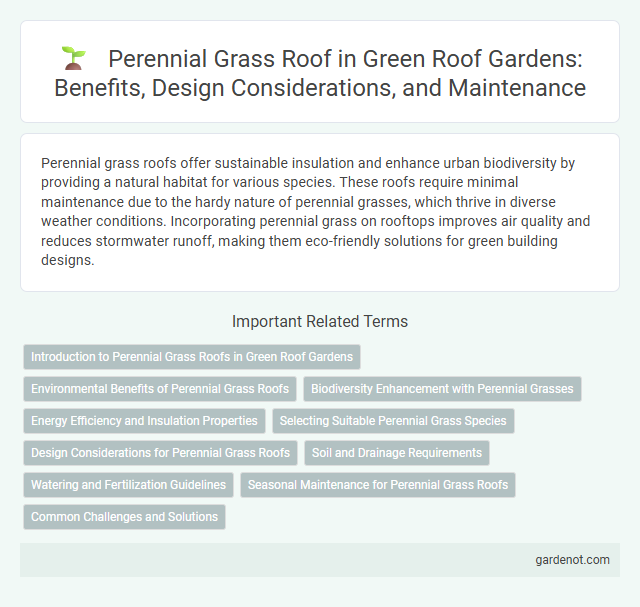Perennial grass roofs offer sustainable insulation and enhance urban biodiversity by providing a natural habitat for various species. These roofs require minimal maintenance due to the hardy nature of perennial grasses, which thrive in diverse weather conditions. Incorporating perennial grass on rooftops improves air quality and reduces stormwater runoff, making them eco-friendly solutions for green building designs.
Introduction to Perennial Grass Roofs in Green Roof Gardens
Perennial grass roofs enhance green roof gardens by offering year-round greenery, improving insulation, and supporting biodiversity. These hardy grasses adapt well to varying weather conditions, reducing maintenance needs while promoting sustainable urban environments. Integrating perennial grass roofs contributes to energy efficiency, stormwater management, and aesthetic appeal in green infrastructure.
Environmental Benefits of Perennial Grass Roofs
Perennial grass roofs significantly enhance urban biodiversity by providing habitats for pollinators and other wildlife, contributing to ecosystem resilience. Their extensive root systems improve air quality by filtering pollutants and sequestering carbon, thereby mitigating urban heat island effects. These green roofs also reduce stormwater runoff through superior water retention, decreasing the burden on drainage systems and lowering flood risks.
Biodiversity Enhancement with Perennial Grasses
Perennial grass roofs significantly boost urban biodiversity by providing habitat and food sources for pollinators, birds, and beneficial insects throughout the year. Their deep root systems improve soil structure and moisture retention, supporting a diverse ecosystem of microorganisms and flora. Integrating a variety of perennial grass species enhances resilience against pests and climate variations, fostering a stable and thriving green roof environment.
Energy Efficiency and Insulation Properties
Perennial grass roofs significantly enhance energy efficiency by providing superior insulation that reduces heat transfer through building roofs, lowering cooling and heating demands. Their dense root systems and layered vegetation improve thermal regulation, maintaining indoor temperatures and minimizing reliance on HVAC systems. Studies show that these green roofs can decrease energy consumption by up to 25%, contributing to sustainable building practices and reduced carbon footprints.
Selecting Suitable Perennial Grass Species
Selecting suitable perennial grass species for a green roof involves prioritizing drought tolerance, root depth, and growth habits that support roof stability and stormwater retention. Species like Festuca ovina (sheep fescue) and Bouteloua gracilis (blue grama) are optimal due to their resilience in varying climates and low maintenance requirements. Proper species selection enhances biodiversity, thermal insulation, and the overall lifespan of the green roof system.
Design Considerations for Perennial Grass Roofs
Perennial grass roofs require careful design considerations such as selecting drought-tolerant species to ensure resilience and low maintenance. Proper substrate depth, typically between 4 to 6 inches, supports root development and moisture retention while preventing structural overload. Incorporating an efficient drainage layer and water-retention membrane optimizes plant health and reduces potential water damage in green roof systems.
Soil and Drainage Requirements
Perennial grass roofs require a well-structured growing medium with a depth of at least 15-20 centimeters to support root development and moisture retention. Soil should be lightweight, well-draining, and rich in organic matter to prevent waterlogging while maintaining adequate nutrient levels for healthy grass growth. Efficient drainage layers, such as gravel or specialized mats, are critical to manage excess water and prevent structural damage to the roof system.
Watering and Fertilization Guidelines
Perennial grass roofs require consistent watering, especially during the first growing season, to establish deep root systems and maintain healthy foliage. Irrigation should be applied deeply but infrequently, promoting drought resistance and preventing waterlogging that can damage the green roof structure. Fertilization with balanced, slow-release fertilizers in early spring supports vigorous growth, while avoiding excessive nutrient inputs that could lead to runoff or ecological imbalances.
Seasonal Maintenance for Perennial Grass Roofs
Seasonal maintenance for perennial grass roofs involves regular trimming to prevent overgrowth and ensure healthy plant development throughout spring, summer, and fall. Inspecting irrigation systems and adjusting watering schedules based on seasonal rainfall can optimize moisture levels for perennial grasses. Removing debris and monitoring for pests or diseases during winter dormancy helps maintain the roof's longevity and aesthetic appeal.
Common Challenges and Solutions
Perennial grass roofs often face challenges such as water retention issues, root penetration damage, and seasonal growth fluctuations that affect their stability and longevity. Implementing high-quality waterproof membranes and root barriers can prevent structural damage while layering drought-tolerant grass species enhances water efficiency during dry periods. Regular maintenance including seasonal trimming and irrigation adjustments ensures optimal health and durability of perennial grass roofing systems.
Perennial grass roof Infographic

 gardenot.com
gardenot.com